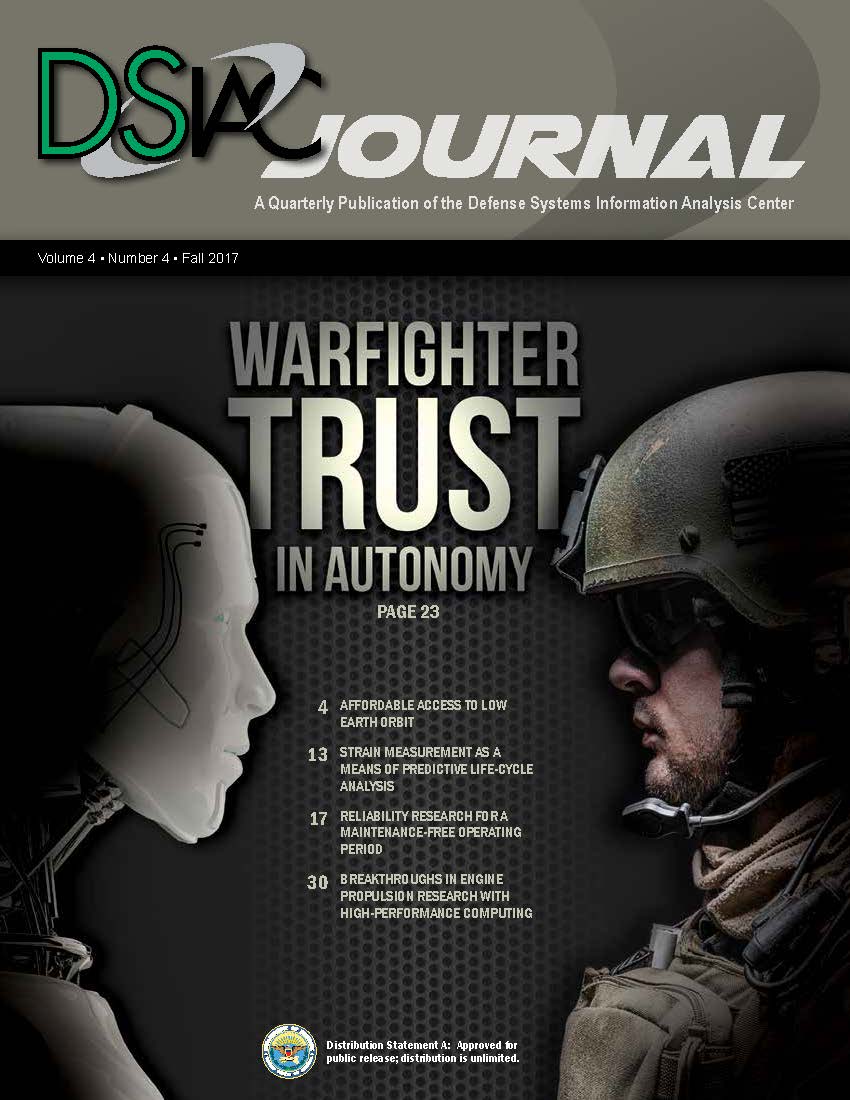an email newsletter released every month highlighting the latest articles, events, technical inquires, and voices from the community
Fall 2017: Volume 4 Number 4

Fall 2017: Volume 4 Number 4
Published: November 1, 2017
“Wow, I didn’t even know research was being done on that subject!”—one of the goals of the DSIAC Journal is to cause the reader to have reactions such as this one when reading these pages and discovering some of the new ideas being studied within the realm of defense systems. Scientific and engineering work on defense system topics is so diverse and widespread in the United States and beyond that the community faces a formidable challenge in staying abreast of the latest findings. The DSIAC Journal exists to help combat this challenge, providing a forum to help researchers, engineers, and technical managers share their work with the larger defense systems community.
As a reminder, there are nine expressed focus areas that DSIAC specializes in: Advanced Materials; Autonomous Systems; Directed Energy; Energetics; Military Sensing; Non-Lethal Weapons; Reliability, Maintainability, Quality, Supportability, and Interoperability; Survivability and Vulnerability; and Weapon Systems. Each quarter, emerging trends in these areas are published in the DSIAC Journal.
Through publication and propagation of cutting-edge defense systems research, the journal helps to, among other things, mitigate redundant research being performed. Whether the work is performed directly by the Department of Defense (DoD) or supporting organizations in academia or industry, sharing the findings and lessons learned promotes knowledge reuse, ultimately saving the defense systems community time and money and enhancing overall science and technology.
The five articles in this issue well represent findings from the diverse defense systems community. Three come from DoD organizations, one is from academia, and one is jointly produced by DSIAC and industry.
This issue’s feature article comes from Jonathan Gillis on the topic of “Warfighter Trust in Autonomy.” Using his experience serving as a Marine and working for the Marine Corps Warfighting Laboratory, Mr. Gillis describes obstacles and then proposes remedies toward integrating autonomous systems into combat units. The goal of this information is to aid autonomous system designers and DoD decision-makers as the inevitable rise of autonomous systems continues.
In our article “Affordable Access to Low Earth Orbit,” DSIAC’s Albert DeFusco and RocketStar CEO Christopher Craddock highlight some tremendous benefits (as well as high costs) of some low earth orbit applications and developments. In particular, research on the latest vehicle and engine technologies is described. The developments in these areas are expected to break through the financial barrier and provide unprecedented affordable access to space.
Our “Strain Measurement as a Means of Predictive Life-Cycle Analysis” article comes from Texas Research Institute/Austin, an academic member of the DSIAC team. In this article, researchers Michael Mazurek, Russell Austin, and Kristen Donnell highlight evolving strain-sensing technology in concert with the advancement of high-strength, low-weight materials (such as those used in aircraft structures) and their benefit for military sensing application as a predictive DoD life-cycle analysis tool.
In addition, our article on “Reliability Research for a Maintenance-Free Operating Period” (MFOP), written by Army Research Laboratory (ARL) scientists Todd Henry, Terrence Johnson, Jeff Gair, and Robert Haynes, discusses how accurately identifying a vehicle’s MFOP offers significant cost savings to the DoD but also requires proper monitoring and dedicated design. This article describes ARL’s research in damage monitoring and topology optimization to make way for the MFOP of defense vehicles.
Additional ARL research is presented in Luis Bravo’s article on “Breakthroughs in Engine Propulsion Research with High-Performance Computing.” Fully predictive modeling of liquid-fueled direct injection engines, which are used in many DoD vehicles, has long been impossible due to the incredible complexity of the physics involved. However, DoD enhancements in high-performance computing have enabled the execution of never-before-seen computer simulations that are proving to be highly accurate. These breakthroughs will allow the DoD to better understand the physics and close existing technical knowledge gaps.
In closing, let me invite you to share your work through the DSIAC Journal. Although many of your peers may be aware of your efforts, there are surely many more who are not. Please contact me at brian.benesch@dsiac.org to get your findings and lessons learned shared for the betterment of the defense systems community, and perhaps your work might be the reason the next reader says “Wow!”

